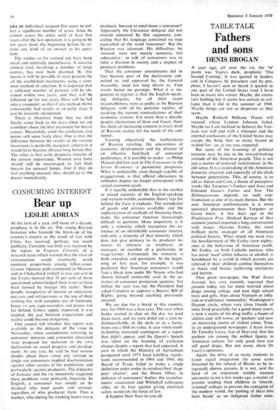MEDICINE
Sign of cancer
JOHN ROWAN WILSON
When I was a young surgeon we all knew how to treat breast cancer. While it wasn't exactly easy, it was at least straightforward. You did an operation called a radical maestectomy, in which you not only removed the breast but also took away, in one piece, the entire mass of soft tissue under the armpit. The logic of this was that cancer of the breast spreads through the lymph channels into lymph glands which are located under the arm. By means of the radical operation you could dispose not only of the tumour but also of any early spread.
After the wound had healed, you then gave x-ray treatment to the operation area, in the hope of destroying any cells that your operation had missed. If your operation was good enough and you had caught the tumour early enough, you then had a pretty good chance of a permanent cure.
It was wonderfully logical. But the trouble with logic is that one always has to start on the basis of certain assumptions. And if these assumptions are in the slightest degree wrong, the whole structure of reasoning falls to the ground.
It is apparent now that our earlier concept of cancer was oversimplified. We visualised it as an irresistible invasive force, spreading through a defenceless body. To leave behind only a few cancer cells was disaster. Hence the preference for radical surgery and wide excision of tissue at a considerable distance from the growth itself. However, it is now clear that the body, far from being a passive spectator of the malignant process, is engaged in a continuous struggle against it. It is because of this that the outlook in cancer, both treated and untreated, is ex- tremely variable and hard to predict. Ex- traordinary things are constantly happening. Large and apparently advanced tumours suddenly stop growing for no apparent reason. Conversely small growths may turn out to be wildly evasive no matter how early they are diagnosed or how radically they are treated.
The exact mechanism of the body's defences against cancer is still not clear, but there is evidence Lhat it is a part of the general immune mechanism which protects us against bacterial infection and also rejects foreign material such as tissue grafts from other individuals. An integral part of this mechanism is the lymph system—including the glands in the armpit which we have been conscientiously removing for so long. The question arises whether the radical operation may be attacking, not only the tumour, but also the body's defences to it.
We need therefore to reconsider our whole approach to breast cancer. And since our knowledge of the pathology is still so scanty, the best way to do this is to go back to the impirical approach which is at the very root of medical science. In other words, forget the theory for the moment and ask the one basic question: does it work or doesn't it? In re- cent years there have been many studies designed to approach breast cancer in this way, by comparing the effects of different patterns of treatment. There are a number of possible combinations. The surgical possibilities are simple excision of the lump, excision of the breast, or excision of the breast together with the lymph glands. With any one of these treatments one may com- bine x-ray therapy before, or alternatively after the operation. Ideally, one should take a comparable series treated by every conceivable method and compare the results.
This is a desperately difficult job. Breast cancers vary a great deal in size, site, and degree of advancement when first recognised. Moreover, it takes a long time to find out whether a cure has been achieved or not. The conventional criterion is the so- called 'five-year cure rate'; one measures the number of patients still surviving five years after treatment. The trouble is that it may
take an individual surgeon five years to col- lect a significant number of cases. Since he cannot assess his series until at least five years after the last operation, it is going to be ten years from the beginning before he at- tains any kind of an answer to his ques- tion.
The studies so far carried out have been small and relatively inconclusive. A massive clinical trial, involving a number of large centres, has now been planned. By this means it will be possible to treat patients by all the established treatments, using a com- mon method of selection. It is expected that a sullicient number of patients will be ob- tained within two years, and they will be followed up for ten years. Data will be fed into a computer, so that if any method shows consistently bad results at an early stage it can be instantly abandoned.
There is therefore hope that we shall finally come back to the days when we are confident about the best treatment for breast cancer. Meanwhile, amid the confusion, two points still seem fairly clear. One is that the difference between the results of the various treatments is probably marginal, otherwise it would have become obvious long before this. The other is that early diagnosis remains of the utmost importance. Women over forty should still be encouraged to feel their breasts for unusual lumps. And if they do feel anything unusual, they should go to the doctor immediately.















































 Previous page
Previous page